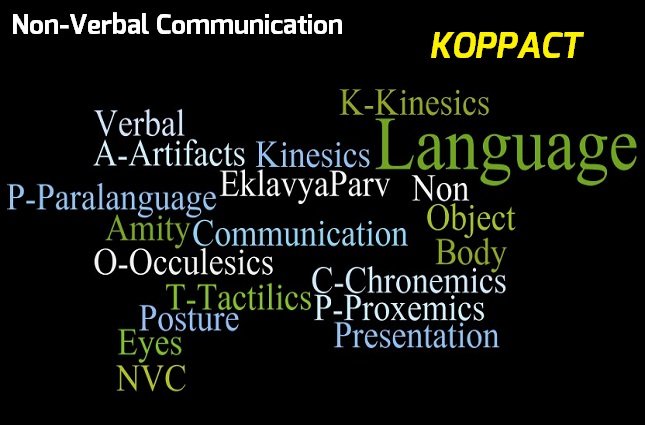Communication is what it does! All living beings are empowered with a special faculty to communicate. They use a language that is not denoted in the dictionary. We know this medium as Non-Verbal Communication. Communication through body language, gestures, face, eyes, time, objects or appearance, touch, space, etc.
We should know that Communication is broadly divided into two categories, according to the Mode it uses:
- Verbal Communication (Verbal Oral/Spoken Communication and Verbal Written Communication)
- Non-verbal communication (KOPPACT)
Communication is the art of expressing ideas and thoughts to people. Listening, speaking, reading, and writing remain the fundamental parts of communication. Whereas listening and Reading are Receptive, Speaking and Writing are Expressive faculties. Communication can be divided into three basic components: they are Presentation Skills (a combination of verbal and non-verbal communication), Writing Skills and Conversation Skills. According to research, any communication includes 7 per cent spoken words, 38 per cent voice and tone, and 55 per cent body language. It is an interesting fact that 93 per cent of our daily communication is non-verbal. Females are found to have much better visual and auditory skills. Here in this essay, we are strictly confining ourselves to its non-verbal aspect.
Non-verbal communication is an integral yet complex part of our overall communication skills. Non-verbal communication is a message or response not expressed in words or hints. Non-verbal signals are a deeply rooted and conscious part of our overall behaviours. It is recognised as a route to discover what the other side wants. It is a combination of the implicit and explicit meanings of words. It gives us information about the emotional state and reinforces the meaning of words. It can play five roles in communication, which are repetition, contradiction, substitution, complementing and accenting. Various things which an individual can take care of during presentations are non-verbal behaviours and spatial arrangements of words. There are various types of non-verbal communication styles which can be abbreviated as “KOPPACT”. It stands for kinesis, oculesics, paralanguage, proxemics, artifactics, chromatics, tactilics. It is explained below in detail:
Kinesics (How we use Body-Posture, Expressions, etc.) includes body language, body movements, gestures, postures, facial expressions, head, and hand movements. It can be used to emphasise what is being said. It has various elements like voice quality, adapters, regulators, affect displays and illustrators. In all non-verbal modes, facial expressions are the most significant as they play 55 per cent of our total non-verbal communication. Facial expressions can be further subdivided into micro-expressions, sign languages, and eye contact. Postures can reflect people’s emotions, attitudes, and intentions. Research has identified a range of postural signals, such as open and closed postures. It helps to determine an individual’s degree of confidence, status, and receptivity to the audience. Moreover, postures help to identify the degree of attention and interpersonal relationships. Gestures are woven into the fabric of daily life. They strengthen our opinion by the movement of hands (wave, point, beckon), nodding, and expressions (nine sentiments or NavRasa). The meaning of gestures is interpreted differently across different cultures. It is important to be clear, as it can lead to misinterpretations. Adapters, symbolic and conversational are three types of gestures.
Kinesics is the nonverbal modality relating to the use of body language through gestures of the head, facial, arms, and hands, as well as posture and making eye contact.
Oculesics (How we use Eyes!) deals with eye span or eye contact. We can deceive people through our eyes. We should try to establish proper eye contact as it can give proper indications to the audience. It can help establish interest, engagement, involvement, and attention with the audience. It helps to serve three purposes. Firstly, it helps to give and receive feedback. Looking at someone lets them know that the receiver is concentrating on the content of their speech, as not maintaining eye contact can indicate disinterest. Secondly, it helps people know when it is their 'turn' to speak. Eye contact is more likely to be continuous when someone is listening, rather than speaking. When a person has finished what they have to say, they will look directly at the other person, and this gives a signal that the arena is open. Thirdly, it helps to communicate something about a relationship between people. When you dislike someone, you tend to avoid eye contact and pupil size is often reduced. On the other hand, the maintenance of positive eye contact signals interest or attraction in the audience. Some examples of this are Narendra Modi and Barack Obama.
Proxemics (How we Use Space!) is the spatial distance, an intimate relation, or closeness between people, groups or societies. It involves embracing, touching and whispering. It is seen that close friends, relatives, and mutual friends share excellent space with each other and can understand each other better. We all have a need for physical space, although that need differs depending on the culture, the situation, and the closeness of the relationship. One can use physical space to communicate many different nonverbal messages, including signals of intimacy and affection, aggression and dominance. While delivering a speech, one must have an eight to ten-foot distance.
There are zones in the Space Language, which we call Spatial Zones:
- Intimate Zone (0’ - 18”)
- Personal Zone (18” – 4’)
- Social Zone (4’-12’)
- Public Zone (12’ - ∞)
As we see that a person feels safe in the intimate zone, the personal bubble is considered to be around 3 feet. That is the diameter of the intimate zone.
Relationships at home or with close friends work in the Intimate and Personal zones. When we communicate within the community (known but not close to us), it is called a Group. When we deal with an open audience or public, we call that a Public Zone.
Paralanguage (How something is said, not what is said!) is the pitch and tone of our verbal message. "How something is said, not what is said." When we speak, other people read our voices in addition to listening to our words. They pay attention to our pace of speaking, time, loudness, tone and inflexion. Our tone of voice can indicate sarcasm, anger, affection, and confidence. Pitch is the high and low modulation of the voice. It depicts anger and happiness. High pitch helps to reinforce with cover and coat. High pitch helps to highlight the important message, and low pitch can convey less importance, fatigue, and disinterest.
Chronemics or timing plays a very important role in a presentation to establish proper sync or wavelength between verbal and non-verbal communications. The sense of time helps to indicate the starting and ending of an event. It can depict interest and disinterest in the audience as well as the speaker. For example, looking at the watch while giving a presentation can indicate disinterest and can prevent the audience from listening, marking the loss of interest. Various aspects of time are temporal processing, cognition, emotions, embodiments, interval time and perception.
Artifactics are the things that one carries. For example, the way of dressing. It adds to one's personality. Our outlook can impress people. It is very important the way one carries oneself. It helps the audience to interpret and analyse us better. Artifactics is a form of nonverbal communication having to do with the way in which one's attire affects the way one communicates.
Touch (or Haptics) can help to reassure people, make them comfortable, or even dissuade and discomfort them. A touch can send a positive or negative signal. A touch. We communicate a great deal through touch. Think about the messages given by the following: a weak handshake, a timid tap on the shoulder, a warm bear hug, a reassuring slap on the back, a patronising pat on the head, or a controlling grip on your arm.
We learn in Haptics/Tactile Communication that we can not trespass into the territory of anyone without knowing:
- Whom can you touch?
- When can you touch?
- How can you touch?
Benefits/Functions of Non-Verbal Communication:
- Complementing
- Conflicting or Contradicting
- Substituting
- Accenting
It strengthens the relationship between people, helps to provide feedback, regulates the flow of communication, keeps people motivated to listen, increases the credibility of the speaker, improves expressions and understanding, gives satisfaction, and even improves popularity. Some advantages of Non-verbal communication are that it helps to communicate with deaf people, respond in silent zones, convey secrets, have conversations with distant people, save time, make conversations short and brief and help to communicate with people who do not understand our language. Non-verbal communication has a few disadvantages, too. It cannot be used to have long conversations, to unveil particulars of the message, is difficult to understand and requires a lot of patience and repetition, cannot be used as a public tool for communication, is less influential, not impressive and impressionable.
People nowadays prefer emails over face-to-face interactions without realising that electronic communications will never be a substitute for the face of someone. As it is popularly said that our actions speak louder than words”, sign language and the language of symbols are understood by all.
About the Author
'You Create Yourself' is the belief that drives EklavyaParv! It is a Life Long Learning Mission with firm belief in the philosophy of Eklavyaism. We share learning on Communication Skills, EdTech, Life Skills, Blended & Innovative Learning and Insights about Career, Skills and Lifelong learning.
Founded by Parveen Sharma, EklavyaParv is part of various pioneering initiatives like EduSoMedia, EduPodcasts, PodMOOCs and Skill-ogy. He is a faculty of English, Communication Skills with globally acknowledged expertise in EdTech and Innovative Teaching. You can listen to his podcasts on all leading platforms.







